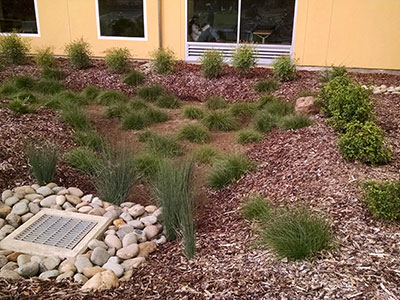We are in the midst of the hurricane and rainy season here in Florida. There are 21 days, on average, of rainfall throughout the month of July, which means we are all dealing with constant runoff. With stormwater management at an all-time high, we’re here to work closely with you to ensure pollutants like trash, oils, and sediment don’t end up calling your property home. Using Best Management Practices, it’s important to design, build, and utilize maintenance applications to control the overflow of water and everything it carries.
Why Stormwater Management Should Be On Your Radar
The objective of stormwater management is to contain water and remove pollutants. Many commercial properties are rich with pavement, roofs, and other surfaces that make it difficult for rainfall to soak into the ground. These materials cause the water to move more rapidly and drain into areas that cause flooding, erosion, mud, and, ultimately, damage. Taking a moment to consider the landscape design of your structures and how you maintain properties to handle runoff is essential.
Construct With All Possibilities in Mind
 Before making any changes or adjustments to your structures or landscape, take stock of what is currently there. Do you know where runoff flows? If the answer is no, step one is finding this out. While you never want to flood your property just to determine how to manage stormwater, you’ll want to take stock of pooling areas, and which spaces are most susceptible to damage.
Before making any changes or adjustments to your structures or landscape, take stock of what is currently there. Do you know where runoff flows? If the answer is no, step one is finding this out. While you never want to flood your property just to determine how to manage stormwater, you’ll want to take stock of pooling areas, and which spaces are most susceptible to damage.
If you are planning a construction project, it’s good to know what type of weather you’re going to end up dealing with and to design and construct accordingly. Low-rise gazebos in hexagonal shapes better withstand wind, making it more likely you won’t have to worry about wood chips, screws, or small building materials making their way into your water source. A hip roof, with ends and sides inclined, gives water an easy pathway to travel, as well. This will ensure your structure has the best chance of standing despite weather conditions.
During the design phases of horticulture projects, a thorough assessment of your landscape is important. This includes understanding hardiness zones to gain insight into how current plants withstand storms and determining new additions to buffer some of the potential damage. Inputting new plant life could be helpful in stopping pollutants from traveling beyond your property, but it could also cause the ground to become too dense for water to soak into the soil. Finding the balance is essential.
Prepare For The Season
Be sure to include porous hard surfaces on your property throughout the design and construction phase to assist in stormwater management. This isn’t limited to grass, soil, and dirt. Permeable pavement is an option that allows rain to seep through into the ground below. Allowing it to soak in reduces the risk of running water carrying debris or causing flooding.
Additionally, infrastructure designed to protect, restore, or mimic the natural water flow will play a part. Culverts, gutters, sewers, and piped drainage are all options that can direct heavy rainfall into areas that are more equipped to handle it.
It’s also critical to understand what materials are on the property that could contribute to the pollution problem caused by heavy rains. Small rocks, fertilizer, and even bits of trash can make their way from your grounds into lakes, rivers, and other bodies of water. A quick clean up can be a tremendous step to ensure many man-made pollutants aren’t part of the problem once the storms hit.
A Few Quick Tips
Develop a Plan
As imperative as it is to include prevention as a topic of discussion in landscape and construction projects, sometimes the problem can only be addressed in current areas after it becomes apparent. When complications arise, determine the next steps. Where can drains be installed? Which plants need removed or better pruned for future storms? What steps need to be taken just before a large weather event hits? Prevention of further or future damage is a necessity.
Conduct Thorough Inspections
Hurricane and the rainy season begin in Florida around the beginning of June. Every May, a trusted team member should conduct inspections of areas that gather the most water and places where runoff moves through. Gutters and drainage systems should be repaired or replaced if necessary. Trees and other plants should be pruned to handle the coming storms.
Manage Trash Collection
It sounds simple, but securing trash or moving it to a more protected area on the grounds will keep water from carrying pollutants across your or onto another’s property or into bodies of water. This could require heavy dumpsters, enclosed spaces, or even moving certain receptacles indoors. It might not be the most attractive sight, but mother nature will thank you.
Consider Stormwater Management Compliance
Certain municipalities require specific actions to be taken when it comes to stormwater management. This could require licensed professional assistance, permits, or specific materials, which may take some time to sort through. Understanding these needs ahead of time will give you a chance to complete what is required before an event occurs.
Be Ready for the Inevitable
We consider landscape water management and irrigation, conservation, and the preservation of natural environments to be one of our top priorities. We work closely with you to plan the design, construction, and management of your commercial property from the first meeting. If this time of year is always a concern for you, consider connecting with us to see what your options are.


